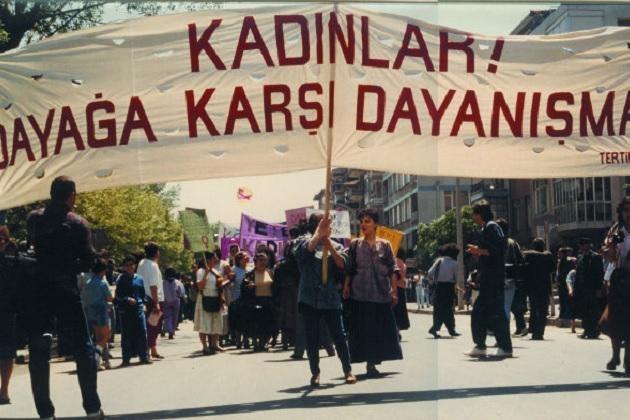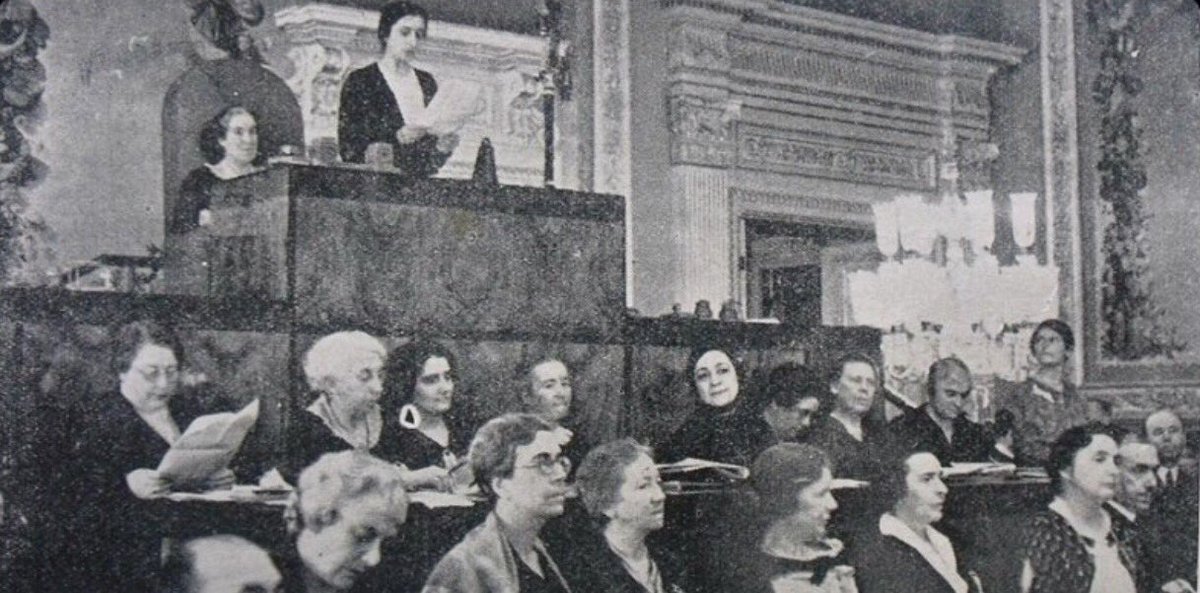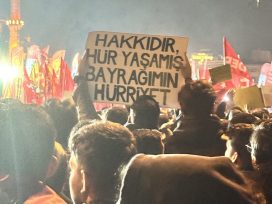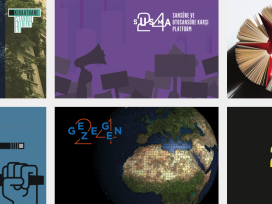Turkey’s recent political history, under the increasingly authoritarian rule of the Islamist Justice and Development Party (AKP), seems to shackle the republic’s foundational principles and its laicist regime. This development is fraught with extremely unfavourable consequences for women in Turkey. In what follows, I will give an overview of the historical background explaining different positions on women’s issues in Turkey today. I will then present the current state of research on women’s history in Turkey and the history of women’s movements there.
In the mid-1980s, a second wave of Turkish feminism triggered an increased interest in feminist academic research. Women’s studies and gender studies became an important area of research within both the social sciences and the humanities, initiated by feminist scholars and academics mostly educated in western universities. Until now, much of the literature has emerged from universities’ women’s studies programmes, as well as graduate programmes in the social sciences, mainly sociology, political sciences, comparative literature, and cultural studies.
My research on the feminist history of Turkish modernization has been inspired by studies on the relationship between the state, Islam, nationalisms, and women in the Middle East. In Gender and Nation, Nira Yuval-Davis showed that the discourse surrounding womanhood in Middle Eastern societies has been incorporated into nationalisms. This usually constructs ‘ideal pasts’ and ‘culturally authentic’ ideals of womanhood, and often serves anti-colonial as well as anti-Western arguments. Therefore, it is productive to analyse the discourses on women to understand the clashes between various claims to cultural authenticity and westernization.

On 17 May 1987, women in Turkey held a massive march for the first time: ‘Solidarity March Against Battering of Women’. Photo via Heinrich Böll Stiftung ISTANBUL
The ‘question of women’s rights’ is a particular area of debate for those who claim to be building a ‘new order’. Images of women serve as icons of the ‘new’, ‘modern’, ‘indigenous’, ‘real’, or ‘essential’ self as opposed to the ‘old’, ‘backward’, ‘traditional’, ‘corrupt’, ‘alien’ or ‘superficial’. These controversial positions take on new forms and shape current identity politics. I will highlight some aspects of this discursive domain by describing the plural forms of modernity experienced in contemporary Turkey, ranging from Islamists to extreme Republicanists or laicists. We will, following this, be able to detect how these positions shaped women as political subjects, and their deep, conflicting histories.
Turkey is an outstanding case among Middle Eastern Muslim societies, with a 200-year history of westernization and modernisation, and laicism as a main pillar of the Turkish Republic. Like many Middle Eastern societies, the nation state has been a vehicle for a break from tradition, the feudal past, and — more so in the Turkish case than elsewhere — with Islam and the cultural heritage of the Ottoman Empire.
Turkey is, for example, the only Muslim country which radically altered its Family Law and Personal Status Codes in civil law, adopting the secular Swiss Civil Code in 1926 with only minor modifications. However, Turkish secularism and its authoritarian character, especially during the early Kemalist republic, has been a topic of political debate since the introduction of a multi-party democratic system in 1945. Critics of the Kemalist regime argue that the early republic became authoritarian by institutionalizing a bureaucratic state structure with a strict control over civil society and religious communities. Over the last thirty years, these criticisms have become hegemonic in both political life and academic discourses. The 1980 military coup, and subsequent period of authoritarian rule, crushed earlier leftist movement and organizations. Afterwards, the regime took on the project of neoliberalisation, from Turgut Özal’s policies in the mid-1980s to the sixteen years of AKP rule. For some political scientists and observers, there has been a shift of power from the Kemalist elite to an elected one, removing bureaucratic elitist characteristics after the 1980s.
New political oppositions, like political Islam, Kurdish nationalism, and independent feminist movements could arise in this transformed public space. Some liberal writers have called this phase the ‘second republic’. Politics of identity and difference have, in this climate, strengthened as people’s demands for the recognition and the extension of political, cultural, and religious rights increased. Sociologists like Nilüfer Göle and many liberal-left writers celebrated these developments, saying they have widened the civil public, giving more space to groups hitherto distanced from the republican modernization project.
It has also been suggested that the AKP initiated a democratization process during the early years of its rule. By 2010, there was still an air of optimism about a more democratized society under AKP rule, particularly among those parts of society that were close to the party.
Four main lines of argument shape the current discourse on women’s issues. These are related to basic problems of the political history of Turkey and impact programmes, policies, and propaganda of the leading political parties and NGOs: Kemalist feminism, second wave Turkish feminism, political Islam, and Kurdish nationalist feminism.
Kemalism was the official ideology of the early republic, which defined the parameters of ‘state feminism’.The wider sphere of ‘Kemalist feminism’ includes women’s organizations and feminists who defend the rights extended to women during the secular legislative reforms of the early republic. Second wave feminism flourished in the mid-1980s and had an impact on the naming and content of women’s discourses. What used to be called ‘Kemalism’, and the women’s rights granted by Atatürk, was renamed ‘Kemalist feminism’. This was, from the perspective of women, a more radical version of Kemalism. Independent feminist organizations and women’s advocates, informed by western feminisms, became the references to define women’s matters, shaping the language and content of state policies. Another important outcome of the coup and its Islamising policies against the radical left was the rise of political Islam. The different phases of the Islamic women’s movement under AKP rule show nuances in the appropriation of feminist language in their claims to be bettering the position of women in Turkey.
Underlying Turkishness
The increasing significance of the Kurdish political movement had an impact on the growing Kurdish women’s movement. From the mid-1990s, Kurdish women raised criticism about the underlying ‘Turkishness’ of second wave Turkish feminism and the lack of attention paid to ethnic disadvantages faced by Kurdish women.
In my view, this is also due to changes in the political climate, leading to attacks on the foundational principles of the republic from different ideological angles (liberal-leftism, Islamism, and Kurdish nationalism). Although most second wave feminists, including myself, criticised the patriarchal Kemalist ‘state feminism’, they held the secular reforms of legislation, education, and public life in high regard. Kemalist feminism is, on this view, no less than the bedrock of women’s struggle for better lives, regardless of ethnicity. Turkish feminists point out that it is this very process of secularism that is currently at stake under AKP rule.
However, it is evident that Kurdish women have been excluded from the Kemalist modernization project. This is partly due to language barriers and the demands of culture and patriarchal family roles. After the 1980s, there has been growing criticism of the authoritarian measures and assimilationist policies implemented during the single party period of the Kemalist regime. Therefore, politicization, which was in line with the Kurdish political movement, has empowered Kurds with a new awareness of their national identity. Commentators on Kurdish feminism mark the shift in the Kurdish movement’s ideological discourse identified as ‘a national liberation struggle aiming at establishing its own state’. This changed its course towards a project of ‘radical democracy’ in the 2000s. Researchers usually refer to the ‘democratic confederalism’ of Abdullah Öcalan, leader and ideologue of the PKK (Kurdistan Workers Party). This is defined as a democratic, ecological, and gender-emancipatory system which aims for the liberation of women from their patriarchal family and culture. In this context, jineoloji (‘science of women’), a revolutionary enculturation programme designed to change patriarchal mentality, is intended to create a culture of gender equality, paying back women’s massive participation in the movement as ‘fighters’, politicians, activists, and members of pro-Kurdish parties and NGOs.
Within the second wave feminism of the 1980s, Turkish feminists have started to reflect on their own national history. There are, however, still blindspots and areas of difficulty. These problems threaten to create an ethnic divide within the feminist movement due to peoples’ different interpretations and experiences of the history of the Turkish Republic.

The 12th IWSA (International Woman Suffrage Alliance) Congress, in Istanbul, Turkey. Photo via ListeList
The first wave of Feminism and the 1935 International Congress of Women
The International Congress of Women (1935), held in Istanbul, ensured international acceptance of the Kemalist regime and its modernization project. However, it also marked the end of an independent women’s movement in Turkey, which had flourished in the lively political atmosphere of the 1908 Constitutional Revolution and continued with the activities of the early republic’s main women’s association, the Union of Turkish Women. Responding to the directive of the single party RPP (Republican People’s Party), the Union dissolved itself shortly after the congress. The new president, who succeeded Nezihhe Muhittin, declared in a confirmation statement that, under ‘state feminism’, the Union had become obsolete, since Turkish women had been granted all rights.
The Turkish modernization project, and Kemalism as the founding ideology of the republic, were inspired by the ideas of Ziya Gökalp, the ideologue of Turkish nationalism in the pre-republic ‘Young Turk’ period. During the first wave of ‘nationalist’ feminism, women’s rights were discussed in the context of topics like family morality. Women were encouraged to see themselves as the enlightened mothers of the nation, educating the generations to come in the ideals of the new nation and the state.
The first wave of feminism developed in two phases. Initially supported by male and female advocates of women’s rights in the late-Ottoman period, it was later promoted by women who became supporters of Kemalist reformism. This first wave was facilitated by modernist men who championed women’s rights, the modernising state, and the process of secularization.
Women were encouraged to take up public roles and participate in the campaign for economic development. There was a call for their services to the new republic and the nation state, underlining their efforts in the patriotic defence of the motherland during the Turkish War of Independence (1919–1922). The first generations of women who benefitted directly from the radical reforms of women’s rights vehemently supported the Kemalist discourse of women’s emancipation. Mina Urgan, a leading socialist and Kemalist intellectual in the 1970s and ‘80s, stated her deep loyalty to Mustafa Kemal in her memoirs written in 1998 at the age of 80:
Now I should state outright that I am a Kemalist and Kemalist to the bone. That is not because Mustafa Kemal danced with me and treated me as a person when I was only a child of eleven years; I am a Kemalist because I would not be who I am if it wasn’t for him. It would be more than unusual if an eighty-year-old woman did not believe in Kemalism in this country. I was small, but I remember very well the curtain in the tram that separated the women’s section from the men’s. With his beautiful hands, Mustafa Kemal tore that curtain down just like all the other curtains that excluded women from public life and shut them in dark corners. He insisted that women are equal to men in all respects. That’s why, for somebody who was only seven or eight years old when the Republic was proclaimed and witnessed his reforms with her own eyes, there is no other way, but take sides with Mustafa Kemal.
From 1935, when the Kadınlar Birliği (Women’s Union) was closed down until the late 1960s, Kemalist discourse and secularism became the main context of the question of women’s rights. Middle or upper-middle class women set up and worked in philanthropic societies aiming to save the ‘other’ women of rural and urban lower classes from ignorance and poverty. Dedication to Kemalism and secularism, as well as women’s economic participation, also characterized the socialist movement that flourished in the 1970s. 1976, for example, saw the establishment of the Turkish Federation of Women’s Associations, Socialist, Marxist and Maoist women’s organizations. İlerici Kadınlar Derneği, (İKD, Progressive Women’s Association), an organization affiliated to the Turkish Communist Party, which had nearly 20,000 members. However, these activities ended with the military coup in 1980.
Second wave feminist movement in the 1980s and its extensions into the first decade of AKP Rule
The 1980s marked a political juncture in Turkey. Most left-wing politics was suppressed, unexpectedly facilitated the establishment of an independent women’s movement based on their demands as women and the formation of a growing public for women’s identity politics. In the political and ideological void left by the coup, feminism became a foothold and a new point of ideological reference, especially for those women who had been politicized in the leftist movement before the coup and become increasingly critical of the patriarchal and androcentric structure of leftist organizations.
Western feminist texts were translated into Turkish, and prestigious publishing houses followed a pioneering feminist publisher – the feminist collective Kadın Çevresi (Women’s Circle, 1986) – by publishing several series on feminism and gender studies. Books about Ottoman women fighting for their rights, such as Serpil Çakır’s volume about a movement for women’s rights in the Ottoman period, raised awareness of women’s topics among the female population of Turkey, regardless of class, ideology, belief, or region.
Until the 1980s, the fight for women’s rights was part of the official discourse of the Kemalist modernisation project, highlighting the state as the initiator of gender reforms. This narrative had to be revised by recognising the efforts of women advocates such as Fatma Aliye, Emine Semiye, Halide Edip Adıvar, Ulviye Mevlan, and Nezihhe Muhittin. It was a moment of awakening for the women in Turkey, enabling them to identify with these pioneers.
While regaining their history, Turkish feminists accepted and included women with divergent political views. In the politically, ideologically, and discursively divided climate of the 1980s, feminist groups were the only organizations prepared for dialogue with people who had different views. They sided with Kemalist feminists in their endeavour to expand equal rights, which had an undeniable significance for all women in the country. They also supported Islamist women in their fight for the right to wear headscarves at universities. Islamist women were, likewise, well disposed towards these feminists because they challenged the patriarchal aspects of the Kemalist state, highlighting the active role of all women in the women’s movement during the period before the republic. Second wave feminism also provided the stimulus for academic feminism and the institutionalization of women’s studies at women’s research centres in Turkey’s main universities during the 1990s. Most of these centres also advocated republican values and women’s rights against the rise of radical Islamist movements.
The independent feminist movement, which flourished in the 1980s radically altered the women’s agenda and discourse surrounding it, enabling women to become a political subject. It enabled ‘women’ to become a political subject. Ömer Çaha has argued that the AKP, which came to power in 2002, initially tapped into the feminist public discourse because it was prevalent and widely supported by the female public and the political sphere in general.
In the 1980s, feminists extensively criticized the cult of gratitude — bordering almost on worship—of Mustafa Kemal as the father of women’s rights. This ongoing emotional attachment to the founding father had hindered the history of women fighting for their rights and impeded historical awareness of women’s ‘herstories’ until the emergence of second wave feminism in Turkey in the mid-1980s.
The Women’s Library and Information Centre Foundation, founded in 1990, has published bibliographies, biographical studies, catalogues of personal archives, and protocols of international women’s conferences. These pioneering works changed both women’s historiography and the course and language of the women’s movement by altering the dominant discourse that celebrated the early republican reforms. In 1985, Turkey signed the United Nations Contract for the Elimination of Discrimination Against Women (CEDAW) which stipulates that governments must amend legislation to provide gender equality.
Different political camps and even state institutions tapped into the feminist language, particularly during the adaptation to EU conventions imposed on Turkey after it obtained candidate status in 1999.
I would argue that feminist issues had a significant influence on the first years of AKP rule and that the female public, based on feminist theory, language, and action forced political leaders and women’s groups to take feminist discourses into account.
Many positive legislative changes were made regarding the Civil Code (2002), Protection of the Family Law (1998), Penalty Code (2004), and the Labour Law (2003) that enforced women’s rights and eliminated discrimination. These legal reforms resulted from campaigns of women’s organizations based on the consensus and alliance of feminists, including Kemalists, Islamists, and Kurdish nationalists, from a strong and lively female public and the actions of women’s movements supported by global networks and international connections.
It is worthwhile to review the main points of the 2004 CEDAW committee report since this document illustrates the state of women’s affairs and gender equality in the early years of the AKP. The committee concluded that domestic violence and sexual abuse were the main areas of action. The Law for the Protection of the Family (1998) could not be implemented efficiently because state and local authorities did not establish institutions that provided support, shelter, and psychological, legal, and social advice to women threatened by domestic violence. The committee also pointed out that the new Civil Code (2002), which gave equal rights to both spouses in all property acquired during marriage, did not apply to marriages entered into before the law was enacted. The underrepresentation of women in politics was identified as another important problem. It was recommended that quotas for female candidates be introduced, and laws about political parties and elections modified accordingly.
The Islamic women’s movement and KADEM (Association of Women and Democracy)
Women’s issues gained global attention with the UN resolution of ‘Ten Years of Women, Peace and Security’ (1975) and the Fourth World Women’s Congress in Beijing (1995), which produced the ‘Beijing Declaration and Platform for Action’. Islamist women also found a platform to debate their position and rights as Muslim women, arguing that Islam has granted them rights and protections against violence and sexual harrassment. Deniz Kandiyoti has argued that, in countries where there is a strong identification of cultural authenticity with Islam, feminist discourse is shaped by Islamic premises that serve as the main reference in favour of women’s rights. The bedrock of Islamist discourse is, he says, ‘to deny that Islamic practices are not necessarily oppressive’ and ‘to assert that oppressive practices are not necessarily Islamic’.
Kemalism is, as I have said, a form of state feminism. I have also argued that cultural authenticity in Turkish nationalism was not based on Islamic symbols, but on a golden age of equal gender relations in the pre-Islamic nomadic Turkic tribes. Therefore, Kemalism did not define women’s rights with reference to Islam. In contrast to Turkey, where the women’s rights discourse was formulated in juxtaposition to Islam, other Middle Eastern societies, such as Egypt, hold that Islam is perfectly compatible with women’s rights. Hence, Muslim women did not see religious identity as a threat to their feminist identity. Late nineteenth century Islamist modernism was, after all, a significant intellectual source which provided a space for women’s rights advocates.
After 1980, a synthesis of Turkish nationalism and moderate Islamism became the hegemonic and official ideology of Turkey, promoted by successive centre-right governments. The rise of political Islam, as well as the expansion and visibility of public Islamic lifestyles, found fruitful ground in the aftermath of the coup, which was mainly directed against the political left. Conservative and religious families sent their children to religious Imam Hatip schools. Following the 1997 coup, the laicist bloc’s last stand against Islamicists, Imam Hatip middle schools and other vocational schools shuttered, eight-year compulsory primary education introduced, and graduates of these schools were discouraged from university study.
In reaction to the ‘28 February Coup’, Islamists gained increasing political power. The AKP obtained the majority of votes in subsequent general elections (2002, 2007, 2011, and July and November 2015). In July 2018, a presidential government system with a weakened parliament and a judiciary system controlled by the president came into effect. Meanwhile, a ‘4+4+4’ education-system was introduced, multiplying Imam Hatip middle schools and the number of their students, including female students; more graduates of Imam Hatip lycees were allowed to enter university programmes. Finally, in 2013, the government lifted the ban on headscarves in universities and other educational institutions, public offices and parliament.
In Passive Revolution, Cihan Tuğal investigates a new hegemony based on the AKP’s electoral victories. This could, he argues, consolidate the party’s base by hybridizing nationalism, Islamism, and globalism and the ‘absorption of radical or fundamentalist Islamism’ through its integration with global capitalism, reconciling Islamic lifestyles with consumerism. From this position, the AKP gained support from ‘peripheral populations’, who believed that they had finally become the ones who dominated the long ‘alienated metropolitan center’, the state, and the ruling centre in general.
What has been called ‘Islamist feminism’ in the 1990s benefitted from postmodern and postcolonial theoretical literature, which critically evaluated the claims of a ‘universal’, western experience of modernity and highlighted ‘multiple’ modernities in non-western societies. On the one hand, Islamist feminists used human rights discourses to defend their rights to freedom of religious belief and the practices according to their faith. On the other hand, however, they refused to adopt the Western model of women’s emancipation based on the particularistic experience of white middle class women from advanced capitalist societies. Postcolonial concepts of ‘subalternity’, ‘hybridity’, and multiculturalism were used to discuss Islam and its relation to modernism, human rights, democracy, and women’s rights. These formations were characterized as hybrid formations opening a discursive space for a new understanding of Islam as an inclusive rather than exclusive religion.
Muslim women transformed the universalistic approaches they thought excluded them. They did so by representing themselves and their own interests through diverse forms of hybridity and alterity to western women. They accepted new forms of dress and comportment as a way of hybridizing women’s rights and Islamic teachings. This is because they had to show to the public that Islam did not, in legal terms, contradict women’s rights or gender equality. By constructing their subjectivities in these ways, they took female followers of the Prophet from his inner circle as their role models and, in doing so, justified their public presence and visibility.
By attempting to create an alternative women’s rights discourse to western feminism, Muslim women made use of feminist arguments about differences in women’s culture, morality, and social capacities in relation to care responsibilities. This eclectic approach, informed by a critique of modernism forwarded by various Third World and Black feminisms, promotes a broader understanding of women’s human rights by asserting that ‘human’ is not to be equated with ‘male’. Referring to the Qur’an and other Islamic texts, Islamic scholars argue that women and men, as subjects of God’s will, are equal partners in creation with the same capabilities and deficiencies as believers. They propose the concept of gender justice based on Islam as an alternative to gender equality.
The three semantic groups referring to justice include equality, balance, and fairness according to the basic texts of Islam, and thus constitute the semantic ground of gender justice as shown by Huriye Martı, a female theologian at Istanbul University:
Critical ideas about the principle of equality having a sexless and stereotyping structure, taken mostly as the basis while explaining gender are being expressed more frequently today […]. Despite the discourses on gender equality, starting from the principle of ensuring equality before the law and rights and opportunities for men to be also given to women, the structure putting the men in the center as a perfect human-being and men and women dissolving into each other will not assure equality, on the contrary the conclusion is that it will become a source of victimization itself.
On this view, gender equality should be treated as part of a broader umbrella of gender justice by accepting natural gender differences, and the division of responsibilities that come with them, as divinely created. Thus, women and men are rendered equally as believers of Islam with complementary human faculties according to their fıtrat (‘by nature’, ‘by birth’).
A third current in the history of women’s rights in Turkey is the search for an authentic feminism within the AKP, shown by the discourse of the women’s NGO, KADEM (Kadın ve Demokrasi Derneği – Association for Woman and Democracy). KADEM, established in 2014, is organized by leading figures and the women’s branch of the AKP. It serves as a conservative Islamist think tank supporting the ruling party, appealing to Islamist women by tapping into a new vocabulary of empowerment, women’s rights, and culturally authentic gender justice.
Leading member Betül Altınsoy Yanılmaz claims that ‘KADEM will break the monopoly of the women’s movement in Turkey and will be the only institution that fulfills the needs of diverse women’s groups in Turkey’. Sare Aydın Yılmaz, academic and KADEM chairperson, said,
This is a non-governmental organisation that takes its reference from social-spiritual values. […] We believe that the two creations (male and female) have different responsibilities and roles in social life. We need an environment in which these responsibilities and roles are distributed in a more just and balanced manner.
The AKP’s social conservatism is based on the Islamic complementarity of sex roles and gender equity, not equality.. Çakıl’s study on KADEM illustrates a shift in discursive strategies about women, which becomes visible in the publications and public speeches of KADEM’s leaders. Çakıl shows that the claims to improve the social status of women and increase their participation in education, the labour force, and politics are maintained in KADEM action programmes supported by the AKP. To justify these claims, they use a language that taps into the discourse surrounding women’s human rights.
-
The current women’s agenda in Turkey
Article 4 of the Turkish constitution stipulates that republic is a secular state. This was confirmed by the new constitution issued following the 2017 referendum. Secular laws in Turkey safeguard women’s rights which secular parts of the society see as being threatened under the AKP rule.
Feminists criticise AKP policies which consider women not as independent individuals but mothers, wives, or family members. The ministry in charge of women’s issues was renamed The Ministry of Family and Social Policies in 2011, never mentioning women.Feminist groups condemned the ruling party’s conservative stance towards women, given its pro-natalist definition of womanhood. Even though the government was not able to completely ban abortion, due to women’s demonstrations and protests, Recep Erdoğan and other AKP representatives made no secret of their opposition to abortion rights. Ministry of Health directives likewise discouraged state hospitals from performing abortions and caesarean sections.
In 2015, the constitutional court ruled to decriminalise religious marriages that were not preceded by a civil marriage. Both the CEDAW committee and feminists criticised this decision, fearing that it would increase the number of polygamous- and child-marriages. Moreover, unregistered religious marriages longer provide legally-guaranteed economic protection in Civil Law (CEDAW report Turkey, 2016). A 2017 change in the Civil Code stipulates that muftus (officials of the Directorate of Religious Affairs) are allowed to conduct civil marriages – 91 years after the enactment of the secular Civil Law (1926). Women’s organisations are concerned that the new legislation might allow religious codes such as the Sharia to interfere in marriage and family.
Given the still high numbers of femicide, domestic violence towards women is another problem. Since 2010, 1972 women have been killed by men, even though some of the victims were under state protection. To raise public awareness, the website kadıncinayetleri.org maps such incidents. According to the research report on domestic violence, 15 per cent of married women reported incidents of sexual violence, 39 per cent physical violence, while 42 per cent said they experienced either physical or sexual violence.The Ministry of Family and Social Policies promised to accelerate the establishment of centres for the prevention and monitoring of violence (called ŞÖNİM in Turkish) in all 81 Turkish provinces. However, only 49 centres have been opened so far.
Among the concluding observations on the seventh periodic report on Turkey (July 2016), the CEDAW committee mentioned some positive developments. They mainly concerned legislative reforms, especially the 2012 enactment of Turkey’s central legislation on violence against women, the Law on the Protection of the Family and Prevention of Violence against Women. The committee also encouraged the application of the government-designed action programmes to accord with the requirements of various international conventions on the elimination of all forms of gender discrimination, as well as the Council of Europe Convention on Preventing and Combating Violence against Women and Domestic Violence (İstanbul Convention, 2012).
The action plan of the AKP Ministry of Family and Social Policy shows that there is an accepted women’s rights discourse to eliminate patriarchal attitudes and stereotypes that discriminate against women, as well as showing attempts to take various measures towards this goal and implementing them according to the provisions of the Istanbul Convention. There are also a number of policy schemes to educate the public in, and raise awareness about, women’s human rights in universities, schools, the Directorate of Religious Affairs, and among government officials in education, religious services, health, the judiciary, prisons, the police, army, and other branches of the security forces. However, there are still unsolved problems mentioned in the CEDAW report on Turkey (2016). They include discrimination towards girls, early and forced marriages, and child brides. There is also high drop-out rates during secondary education to consider. ‘Honour murders’ and forced suicides are a particular area of concern.So is low labour force participation, as well as underrepresentation in national and local parliaments and other decision-making bodies.
The final draft report by GREVIO (Group of Experts on Action against Violence against Women) acknowledges the legislative and practical achievements of Turkish authorities in creating institutional mechanisms for the prevention of violence. However, it also emphasises diversions from the basic principles of gender equality and the persistence of deep-rooted discriminatory stereotypes concerning the roles and responsibilities of women and men in speeches of AKP leaders and other Turkish authorities responsible for implementing these measures. This might undermine the positive legislation that is yet to be put into effect. Lately, LGBT pride demonstrations were banned on the grounds that they were violating the values and norms of society. This clearly hints how AKP’s conservative Islamist politicians interpret human rights.
-
Conclusion
Second wave feminism in Turkey brought power relations between the sexes in the private sphere into question and politicised what used to merely be seen as ‘private matters’. However, as scholars such as Nancy Fraser today claim, neoliberalism has invaded the sphere of feminist politics on identity and difference, celebrating the empowerment of women as individuals, women’s entrepreneurship, project feminism, amongst other things, in combination with conservative views about ‘difference’, ‘woman power’, and the ‘family values’ of the New Right. Feminism has, as a result, lost its potential as a critical opposition movement to capitalist modernity.
When discussing the Islamist women’s movement and its alleged liberating impact on women, we must reconsider the critical views by feminists such as Iris Marion Young about the risky ground of ‘politics of cultural difference’. Demands to recognise how certain groups’ or communities’ cultural distinctiveness might overlook specific forms of group-based injustices and regulatory mechanisms that control women. As Young states, ‘religious adherents often take doctrine and ceremony not to simply helping to define their identities, but also as obligatory for them’.
In my view, enacting secular legislation is one reason for solidarity and collaboration between women from different parts of society, with different backgrounds and beliefs – both religious and secular. We must ask what kind of change could be embraced by both religious and secular women. One answer would be those initiated and justified by religious authorities and divine providence. Given their doctrinal character, they would be difficult to reverse.
Finally, I would like to restate the critical potential of feminism. It is necessity to reconstruct ‘women’ as political subjects based on the common ground of emancipation. Only this way can we n avert the consequences of capitalist modernity coupled with new forms of patriarchy. These forms continue to harm not only women’s lives but also their shared lives with men.
This article is the modified version of the Käthe Leichter Lecture the author gave as one of the visiting professors at the Department of History, University of Vienna, on 7 November 2017.









